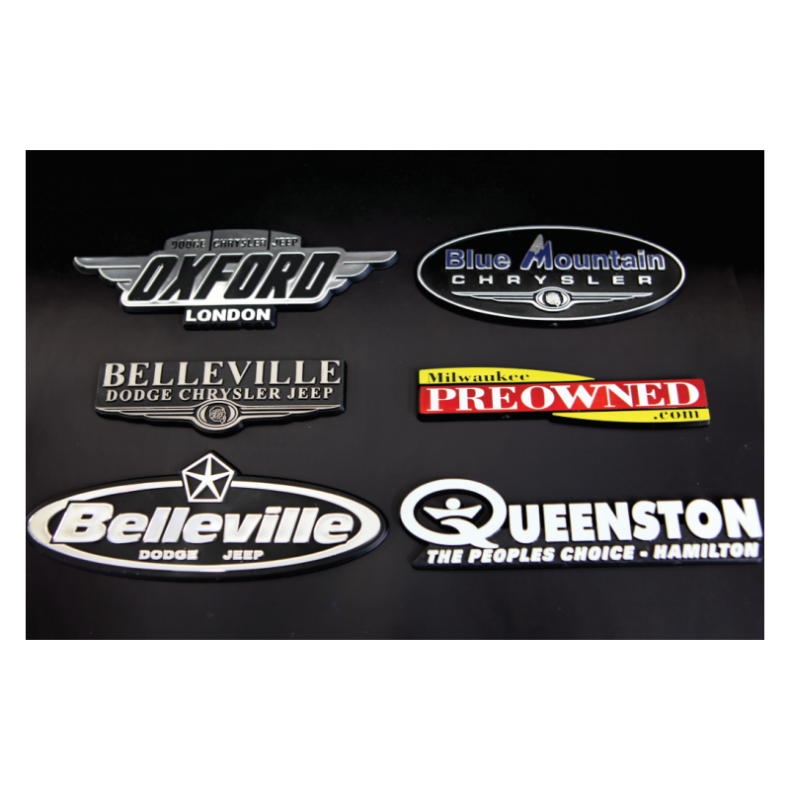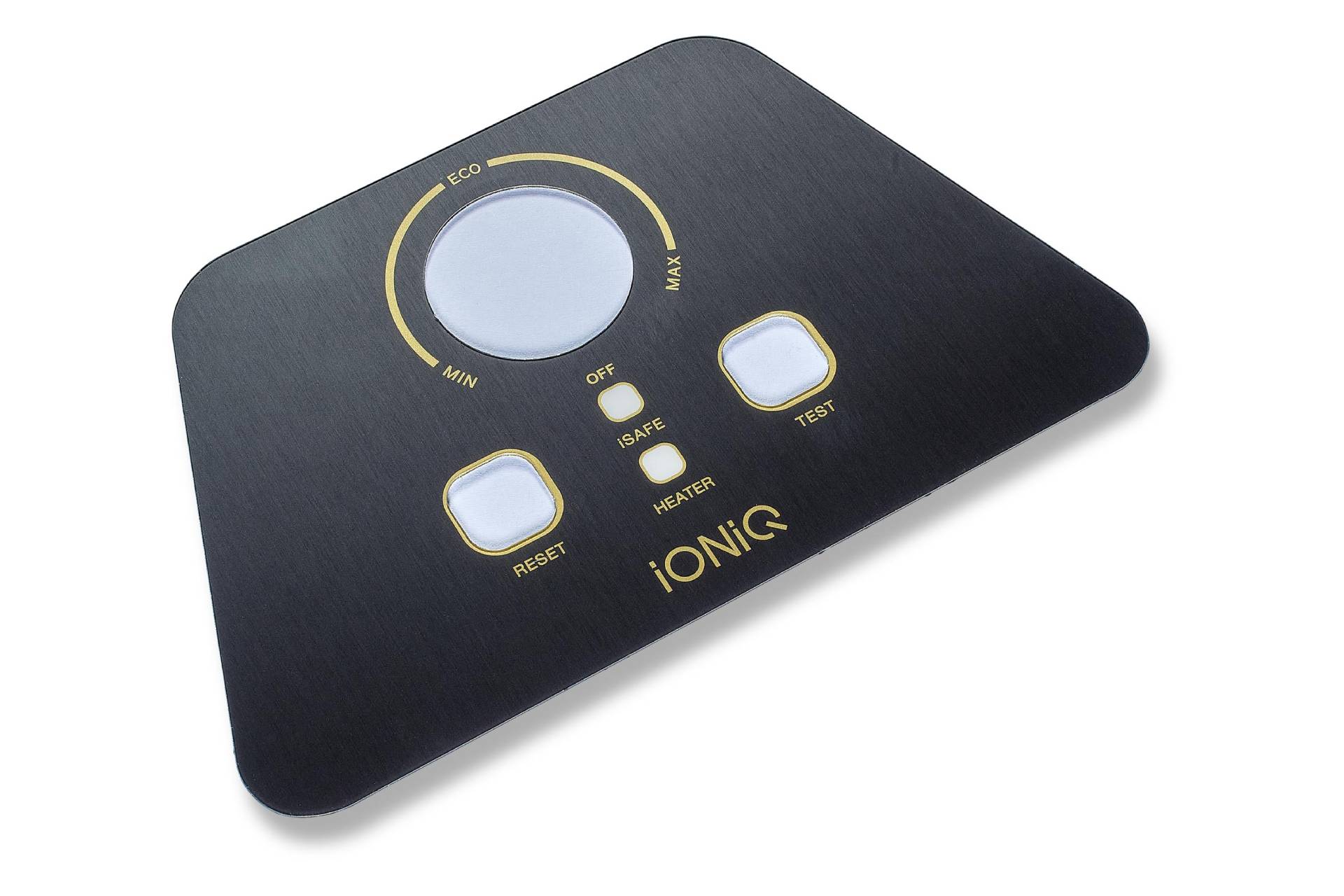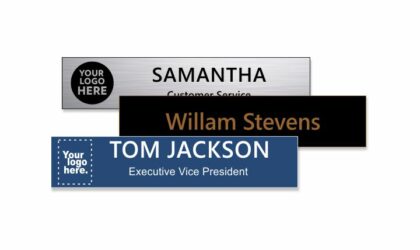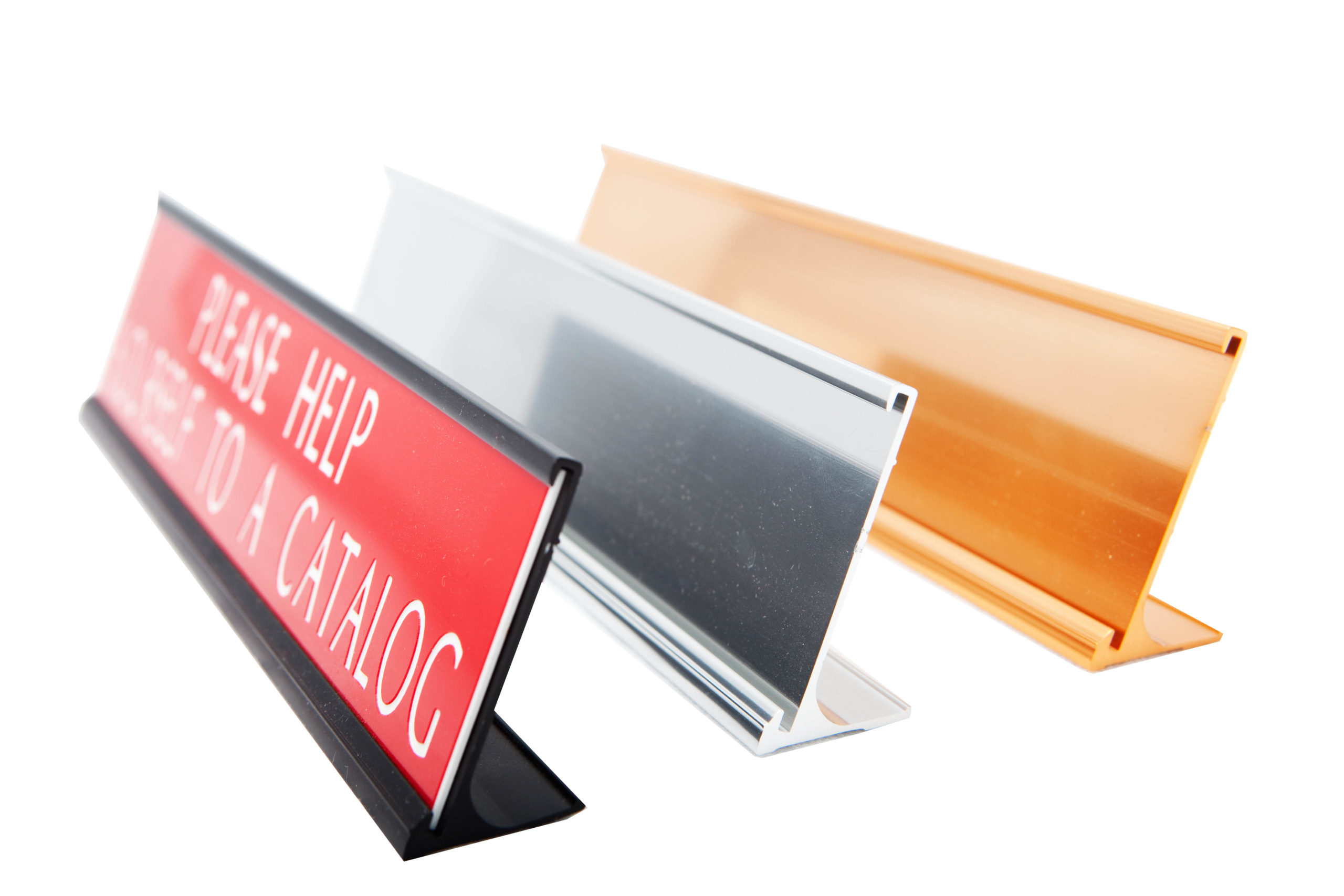Understanding Exactly How Plastic Nameplates Work: Insights Into Their Functionality and Benefits
Plastic nameplates are necessary devices for recognition and interaction in numerous atmospheres. Built from long lasting materials like acrylic and PVC, they provide both resilience and visual allure. Numerous printing strategies improve their exposure and branding potential. Comprehending their performance discloses not only their sensible applications but likewise the benefits they offer companies. As sectors evolve, the function of plastic nameplates might change, motivating a better check out their continuous significance and innovation.
The Products Behind Plastic Nameplates
Plastic nameplates are crafted from a variety of materials, each picked for its distinct homes and viability for various applications. Usual materials consist of acrylic, polycarbonate, and PVC, each offering distinctive benefits. Polymer is favored for its quality and lightweight nature, making it optimal for interior usage and display screen objectives. Polycarbonate, known for its high effect resistance, is commonly selected for environments where sturdiness is vital (Plastic Nameplates). PVC, on the various other hand, gives an affordable option with respectable climate resistance, ideal for outdoor applications.Additionally, the selection of product can influence elements such as shade retention, ease of printing, and total aesthetic appeal. This option process assurances that the last product fulfills particular needs, whether for branding, recognition, or decorative objectives. Understanding the properties of these materials aids in making educated choices when picking plastic nameplates for different requirements
Production Processes of Plastic Nameplates
The production procedures of plastic nameplates include a number of essential actions that assure quality and sturdiness. Secret facets include product choice techniques, different printing methods, and finishing and layer choices. Understanding these components is crucial for creating effective and cosmetically pleasing nameplates.
Material Option Techniques
Picking the ideal materials for making plastic nameplates is vital for guaranteeing sturdiness, visual charm, and capability. Different plastic kinds are available, each offering distinct homes fit for different applications. Polyvinyl chloride (PVC) is prominent for its price and resistance to ecological aspects, making it optimal for outside use. Acrylonitrile butadiene styrene (ABDOMINAL MUSCLE) provides boosted influence resistance and is typically chosen for its remarkable strength and convenience. In addition, polycarbonate is preferred for applications requiring transparency and high effect resistance. The option procedure involves thinking about aspects such as the planned usage, ecological exposure, and desired visual top qualities. Eventually, careful material selection substantially affects the performance and durability of plastic nameplates, dealing with varied sector needs.
Printing Methods Overview
Material choice prepares for the succeeding printing methods used in creating plastic nameplates. Numerous strategies, such as display printing, electronic printing, and pad printing, are utilized to achieve top notch styles and sturdy finishes. Screen printing is favored for its ability to produce vivid shades and is suitable for huge runs. Digital printing, on the various other hand, uses adaptability and precision, making it perfect for smaller sized orders with complex layouts or variable information. Pad printing enables the transfer of photos onto irregular surfaces, fitting complex forms. Each printing approach contributes uniquely to the end product's look and long life, guaranteeing that the nameplates properly share the desired message and stand up to ecological factors.
Finishing and Layer Options
Finishing and finishing alternatives play a vital role in boosting the toughness and aesthetic appeal of plastic nameplates. Numerous techniques, such as UV covering, provide a safety layer that resists scrapes and fading, significantly expanding the product's life-span. Additionally, laminating flooring options can use a matte or shiny surface, enabling for personalization to match branding needs. Plating and electroplating are additionally prominent methods, including a metal shine while boosting corrosion resistance. These layers not just improve look but also add to the nameplate's capability by securing versus environmental aspects. Specialized coatings, such as anti-graffiti layers, warranty that nameplates preserve their clarity and visual charm in challenging conditions. The best completing and finish options can greatly enhance the overall value of plastic nameplates.
Style Choices for Customization
While exploring style alternatives for personalization, one finds a vast range of possibilities that can enhance the aesthetic and functional charm of plastic nameplates. Shade option is a key factor to consider, as lively colors can stand out while neutral tones promote expertise. Numerous font style selections and sizes furthermore personalize nameplates, making sure legibility and positioning with brand identity.Incorporating logo designs or images adds a distinct touch, strengthening business branding. Shape personalization allows for unique designs, varying from conventional rectangles to extra elaborate forms, providing to certain themes or environments.Textures such as matte or shiny finishes can additionally influence the overall appearance, providing a tactile measurement. In addition, the integration of attractive elements like backgrounds or borders improves visual rate of interest. These customization choices jointly enable companies to develop plastic nameplates that successfully interact their identity and message while fulfilling sensible needs.

Toughness and Longevity of Plastic Nameplates
Although lots of variables affect the sturdiness of plastic nameplates, the option of product and manufacturing processes plays a substantial duty in their longevity. Top quality plastics, such as polycarbonate and acrylic, are usually chosen for their inherent resistance to climate, uv, and influence radiation. These materials can withstand harsh ecological problems without significant deterioration, guaranteeing that nameplates remain intact over time.Furthermore, progressed production methods, such as shot molding and laser engraving, contribute to the effectiveness of plastic nameplates. These procedures produce resilient and specific engravings that withstand fading and wear. In addition, safety finishes might be related to enhance resistance to scratches and chemicals, better prolonging their lifespan.Ultimately, the mix of high quality materials and reliable manufacturing processes guarantees that plastic nameplates maintain their performance and appearance for many years, making them a reputable selection for numerous applications.
Applications Throughout Different Industries
Plastic nameplates offer a variety of necessary features throughout various sectors. They are typically made use of for industrial tools recognition, making certain clear labeling for safety and security and functional performance. Additionally, they offer efficient office signage options and play a critical role in safety and compliance markings, highlighting their versatility and value in varied settings.
Industrial Tools Recognition
Efficient industrial devices identification is crucial across different markets, as it ensures security, effectiveness, and compliance with governing requirements. Plastic nameplates offer as useful site an essential device in this procedure, supplying long lasting and clear identification for machinery and tools. Industries such as energy, building and construction, and production use these nameplates to display critical information, including operating instructions, hazard warnings, and maintenance timetables. Their strength to severe settings assurances that essential information remains accessible, lowering the threat of crashes and functional downtime. Additionally, customizable attributes enable branding and specific identifying demands, making plastic nameplates flexible throughout applications. In general, efficient tools identification via plastic nameplates promotes a more secure workplace while improving performance in diverse industrial setups.
Office Signage Solutions

In different industries, the relevance of clear interaction prolongs past commercial equipment to workplace atmospheres where signage plays a crucial duty. Plastic nameplates work as reliable workplace signs services, supplying important info such as worker names, task titles, and department designations. These nameplates improve professionalism and reliability and promote a welcoming environment, assisting both staff and visitors in navigating the work area. Additionally, they offer customization alternatives, permitting organizations to align signage with branding and aesthetic preferences. In settings like medical facilities, academic organizations, and corporate offices, clear and resilient signage guarantees efficient interaction and adds to organizational efficiency. Ultimately, using plastic nameplates in workplace atmospheres not only enhances quality yet likewise promotes a cohesive and well organized work space.
Safety and Compliance Markings
While lots of businesses prioritize looks and branding in their safety, conformity and signage markings are just as vital throughout different markets. These markings offer as essential devices for interaction, assuring that clients and staff members know potential risks, security protocols, and regulative needs. In manufacturing, as an example, plastic nameplates commonly display alerting tags and use instructions to alleviate dangers. In medical care, conformity signage notifies employees regarding hygiene practices and equipment use, thereby promoting a secure setting. Furthermore, the toughness of plastic nameplates makes them suitable for different setups, standing up to wear and tear from ecological elements. In general, safety and conformity markings improve operational effectiveness, promote wellness, and assurance adherence to industry standards, making them crucial in modern workplaces.
Benefits of Utilizing Plastic Nameplates
Many advantages make plastic nameplates an appealing option for organizations and companies. One key benefit is their resilience; plastic nameplates are resistant read review to fading, moisture, and numerous environmental elements, ensuring durability in varied settings. In addition, they are lightweight, making them very easy to relocate and set up as needed.Cost-effectiveness is another substantial advantage. Plastic nameplates normally require lower manufacturing expenses contrasted to metal or timber options, allowing organizations to keep spending plans while attaining expert branding. Their flexibility also stands apart, as they can be customized in numerous forms, sizes, and colors to match branding requirements.Furthermore, plastic nameplates can be conveniently printed with high-resolution designs, advertising clear exposure and reliable interaction. They are typically made from recyclable products, lining up with environmentally aware methods. These mixed benefits improve the capability and allure of plastic nameplates for a range of applications in different markets.

Tips for Choosing the Right Nameplate for Your Needs
Selecting the appropriate nameplate can greatly boost a company's branding and communication initiatives. To make an educated decision, one should first consider the product. Plastic nameplates supply toughness and versatility, making them excellent for various settings. Next off, review the design elements, including size, shade, and font style, ensuring they straighten with the organization's branding guidelines.Additionally, it is crucial to analyze the designated use of the nameplate. For instance, if it needs to withstand outside problems, picking UV-resistant alternatives is advisable. Customization is one more vital variable; customized nameplates can mirror uniqueness and professionalism.Lastly, spending plan considerations should not be forgotten. Comparing costs across different distributors while factoring in quality will certainly assist in locating an appropriate remedy. By taking these elements right into account, companies can choose a nameplate that successfully communicates their identification and purpose.
Frequently Asked Concerns
Can Plastic Nameplates Be Recycled After Use?
Plastic nameplates can be reused, depending upon the sort of plastic made why not try these out use of and local recycling centers. Correct disposal and recycling methods add to environmental sustainability, motivating the decrease of plastic waste in land fills.
How Do I Clean and Maintain My Plastic Nameplate?

Are Plastic Nameplates Waterproof or Water-Resistant?
Plastic nameplates generally show water-resistant properties, shielding them from small wetness exposure. Nevertheless, prolonged submersion or harsh problems might jeopardize their honesty. Plastic Nameplates. Individuals must take into consideration specific materials and layers for enhanced water-proof capacities when choosing nameplates
What Is the Ordinary Life-span of a Plastic Nameplate?
The average lifespan of a plastic nameplate usually varies from 5 to 10 years, relying on variables such as ecological direct exposure, material high quality, and maintenance. Routine care can extend its usability and look considerably.
Can I Order a Nameplate in a Details Shape?
Customized shape options for nameplates are commonly offered via numerous manufacturers. Customers can request details styles, ensuring that the nameplate fulfills their practical and visual requirements while keeping sturdiness and quality throughout its life-span. Material choice lays the groundwork for the succeeding printing approaches made use of in creating plastic nameplates. Many variables affect the resilience of plastic nameplates, the choice of product and production processes plays a substantial function in their longevity. These products can stand up to rough ecological conditions without substantial degradation, assuring that nameplates stay undamaged over time.Furthermore, advanced production techniques, such as shot molding and laser engraving, contribute to the toughness of plastic nameplates. Plastic nameplates can be recycled, depending on the kind of plastic utilized and regional reusing centers. The typical life expectancy of a plastic nameplate generally ranges from five to 10 years, depending on aspects such as environmental direct exposure, worldly high quality, and upkeep.